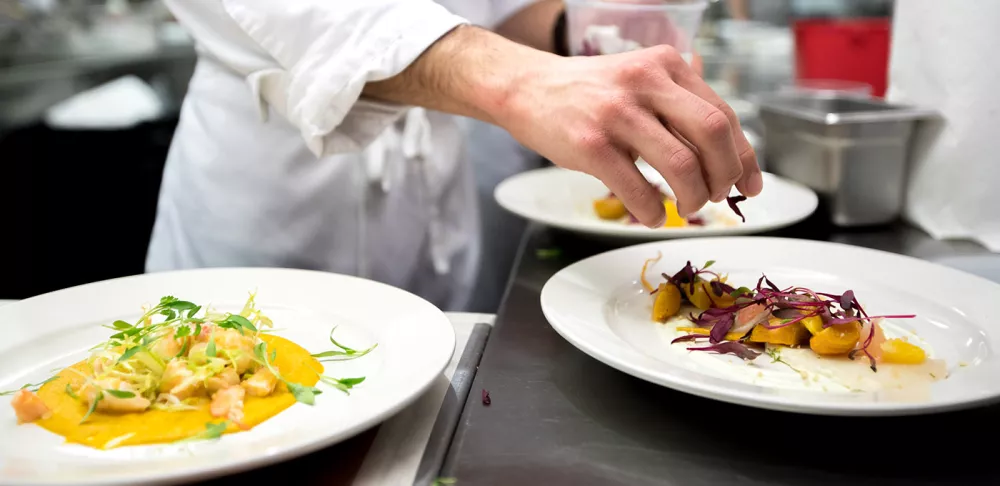The final component of ICE’s Culinary Arts program is an externship, which is an in-the-field, working position at a culinary business where students gain hands-on experience.
The process of landing an externship at a restaurant is slightly different than the typical office interview process, as it allows you to experience the kitchen, meet the team and even show off some of your skills. Called a “trail" or “stage," this is an opportunity for you to evaluate the restaurant, just as much as they are evaluating you.
As a student, I poured over ICE alumna Pamela Vachon’s blog post on her externship search. Reading what she experienced on each trail helped settle my nerves and gave me an idea about what to expect when staging.
Related:What is an Externship?
I worked full-time throughout culinary school, so I had to complete my externship hours on the weekend. My career services advisor told me this could be a sticking point with some restaurants, so I hoped that doing more trails would give me options who hit the other criteria I was looking for, including:
- Who will I be learning from and working directly with?
- What is the vibe between front-of-house and back-of-house, and how do they interact?
- Are there women in the kitchen and diversity amongst the staff?
- How big is the restaurant, what kind of food does it serve and what’s its reputation?
- What kinds of tasks will I be doing? What can I expect to experience?
With these questions in mind, let’s dive into the four restaurants I staged at. To note, the conclusions I drew about each workplace are unique to me and what I was looking for. Others may have different experiences at these same restaurants, and I encourage you to trail at any and/or all if you’re interested.
Olmsted
My first trail was at Olmsted by Chef/Owner Greg Baxtrom. I had eaten there recently and was impressed by the food and standout service. I arrived for the trail a couple of hours before service and helped the sous chef make family meal. While I prepped vegetables, he explained how the restaurant functioned, the different stations on their line and some of the dishes on the menu. There wasn’t too much hands-on cooking for me to do, so I worked as diligently and precisely as I could, then observed his cooking process and asked what I hoped were thoughtful questions.
I met some of the other chefs and front-of-house staff during family meal, but felt incredibly awkward being the new person as no one introduced me and I was too intimidated to speak up. During service, I stood behind the sous chef as he expedited. The timing of the tickets, the overseeing of the dining room and checking each plate before it was sent to the floor was mesmerizing — it was a dance that gave me a better understanding of how all the pieces of a restaurant fit together. From where I stood, I could also see into the open kitchen and observe the three-person line as they worked. After the first wave of diners, the sous had the chefs prepare a few small bites so I could sample different dishes, which was an unexpected treat. Afterward, I was told I could head out and would hear from management on next steps.
Olmsted takeaways: While the food was delicious, there were few female employees (none in the kitchen) and I didn’t want to work with only men. But the trail was paid — a big bonus for me!
Hart’s
Next, I ventured to another restaurant in Brooklyn: Hart’s. It was a leaner operation than Olmsted, so I was able to do more hands-on work to help the team prep for service. I portioned out burgers, cut vegetables and picked herbs. The sous chef and two line cooks each introduced themselves, explained what they were working on and called me over to watch or work one-on-one with them. The environment was laid-back but focused and the team was inclusive and respectful.
Prior to service, we paused for family meal, which we shared with the front-of-house in a family-style format. Then I helped ready the stations for service and watched the plates come together as the first orders came in. The upstairs kitchen was impossibly tiny, with just enough space for the three chefs to stand side-by-side — but the team was organized and neat, and the dishes came out beautifully. At this point, I was just observing, but I was awed by the coordination and communication of just three people to feed the whole restaurant.
I was offered the opportunity to take a seat at the bar and order tastes of whatever dishes I wanted to try. This felt too good to be true, so I only tried a few items, including the restaurant’s famed clam toast, which held up to the hype.
Hart’s takeaways: A small team means more responsibilities and opportunities to try new things, and it was important to me that the chefs were intentional and inclusive. The head chef was a woman, but unfortunately was out of town the day I trailed so I didn’t get the opportunity to meet her.
Oxalis
The following weekend I staged at Oxalis, a Michelin-starred restaurant with a seasonal tasting menu by Chef Nico Russell in Prospect Heights, Brooklyn. Upon arriving, I realized this restaurant was on a different level than the trails I had previously done. The chef de cuisine explained that perfection isn’t the goal, it’s expected, and I could see each station working with a high level of focus on their mise en place. I was assigned to work with a chef de partie for the trail, and I assisted with slicing pancetta and picking herbs. As the servers arrived, they introduced themselves, and I realized everyone addressed each other as “Chef” as a sign of respect.
During service, I mostly observed the chef I was trailing, helping out a few times with simpler tasks like flipping crêpes. Again, I was struck with the intense focus, high standards and efficiency Chef had as he worked. He never stopped moving and was calm and collected, and explained what he was doing as he performed each action. I also had the opportunity to watch the chefs on garde manger and pastry as they cooked and plated, and each was happy to teach me about the ingredients and techniques they were using.
After observing service from a few different stations, I was given a seat at the bar. The chef de cuisine brought out samples of a variety of dishes for me to taste. It was the first time I had ever been inside such an intentional restaurant and probably the best “meal” I’d had to date. The chef told me my weekends-only schedule wasn’t ideal, and they’d be in touch.
Oxalis takeaways: The expectation of perfection was intimidating, but the vibes were positive, inclusive and encouraging. I appreciated that many of the chefs were open to teaching me throughout the trail and I knew I would be exposed to unique ingredients and techniques here.
Locanda Verde
The only restaurant I staged at in Manhattan — and by far the largest — was at Locanda Verde, a popular Italian restaurant by Chef Andrew Carmellini and partner Robert De Niro. Yes, the Bob De Niro. (Spoiler alert: I plated his salad!!!!)
Two recent culinary school graduates were working garde manger, and I was assigned to work with them. They explained their prep list and the different dishes they were responsible for, and we got to work — I helped prep garnishes for salads and mised out ingredients for the vinaigrettes. The downstairs kitchen was huge and each station had their assigned area where they were prepping.
When we went upstairs for service, the garde manger chefs showed me how to set up the station and plate each dish. As the orders came in, I assisted with plating salads, cooked lamb sliders, toasted bread and spooned and seasoned whipped ricotta, making sure to let them approve before passing to the bussers. The orders came in fast, and soon we were flooded. It was more tickets than I’d seen at any of the other restaurants I’d staged at. We couldn’t keep up, and one of the chefs from a different station came over to bail us out. The expeditor called me over so I could observe his process of managing orders and get a sense for the flow of the restaurant. He had the various stations prepare small bites so I could taste them — the pastas were heavenly.
Locanda Verde takeaways: As the biggest restaurant I trailed, this kitchen would teach me how to work at a fast pace to keep up with orders, and it also had the largest menu, meaning more ingredients to get my hands on. Though I was comfortable with the garde manger chefs, I wasn’t sure they would be the best teachers.
I was offered externships at three of the four restaurants, and I chose Oxalis. It is a high-caliber restaurant with an experienced team who are respectful, inclusive and willing to teach. Being compensated was important, but having the best experience and learning as much as I could from a restaurant that would help shape my future took priority.
When I signed my new hire paperwork and saw that I would be paid was the cherry on top.
Trailing Tips:
- Be prepared. Bring your knife roll, tweezers, Sharpie, notepad, pen and wear your uniform (including shoes and hat!).
- Be attentive. Ask questions, take notes and don’t lean on the counters or against the wall as this signals laziness and disinterest.
- Be on time. That should be a given.
- Research. Take a look at the menu, know the dining style and have a few reasons prepared for why you’re interested in working there before you arrive. I felt uncomfortable that I had never eaten at many of the restaurants I staged at but later realized that’s very common.
- Observe. It’s hard to absorb everything while you’re trying to impress but look around as much as you can. See how the staff treats each other, what the vibe during prep and service is, how’s the family meal, is the space comfortable, etc.
- Take notes after. You’ll probably stage at multiple restaurants to find the best fit, and it’s helpful to jot down notes about each experience, so when it’s decision time, you fully remember how you felt about each site.






